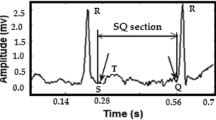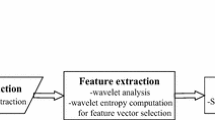Abstract
This paper presents an algorithm for predicting termination of paroxysmal atrial fibrillation (AF) attacks using features extracted from the atrial activity (AA) and heart rate variability (HRV) signals. First, AA signal was decomposed into a set of intrinsic mode functions (IMFs) using empirical mode decomposition method. Then, power spectrums of the AA and its IMFs (second, third, and forth components) were obtained, and the peak frequency of the power spectral densities were extracted. These features were complemented with three additional features consisting of mean, skewness, and kurtosis of the HRV signal. These seven features were then reduced to only two features by the generalized discriminant analysis technique. This not only reduces the number of the input features but also increases the classification accuracy by selecting most discriminating features. Finally, a linear classifier was used to classify AF episodes from AF termination database. This database consists of three types of AF episodes: N type (non-terminated AF episode), S type (terminated 1 min after the end of the record), and T type (terminated immediately after the end of the record). The obtained sensitivity, specificity, positive predictivity, and negative predictivity were 94, 97, 92, and 96 %, respectively. The important advantage of the proposed method comparing to the other existing approaches is that our algorithm can simultaneously discriminate three types of AF episodes with high accuracy.













Similar content being viewed by others
References
Alcaraz R, Rieta JJ (2008) Wavelet bidomain sample entropy analysis to predict spontaneous termination of atrial fibrillation. Physiol Meas 29(1):65–80
Alcaraz R, Rieta JJ (2009) Sample entropy of the main atrial wave predicts spontaneous termination of paroxysmal atrial fibrillation. Med Eng Phys 31(8):917–922
Al-Khatib SM, Wilkinson WE, Sanders LL, McCarthy EA, Pritchett ELC (2000) Observations on the transition from intermittent to permanent atrial fibrillation. Am Heart J 140(1):142–145
Chiarugi F, Varanini M, Cantini F, Conforti F, Vrouchos G (2007) Noninvasive ECG as a tool for predicting termination of paroxysmal atrial fibrillation. IEEE Trans Biomed Eng 54(8):1399–1406
Feinberg WM, Blackshear JL, Laupacis A, Kronmal R, Hart RG (1995) Prevalence, age distribution, and gender of patients with atrial fibrillation. Arch Intern Med 155(5):469–473
Fuster V, Rydén LE, Cannom DS, Crijns HJ, Curtis AB, Ellenbogen KA et al (2006) ACC/AHA/ESC 2006 guidelines for the management of patients with atrial fibrillation: a report of the American College of Cardiology/American Heart Association task force on practice guidelines and the European Society of Cardiology committee for practice guidelines (writing committee to revise the 2001 guidelines for the management of patients with atrial fibrillation): developed in collaboration with the european heart rhythm association and the heart rhythm society. Circulation 114:e257–e354
Go AS, Hylek EM, Phillips KA, Chang Y, Henault LE, Selby JV, Singer DE (2001) Prevalence of diagnosed atrial fibrillation in adults. J Am Med Assoc 285(18):2370–2375
Hamilton PS, Tompkins WJ (1986) Quantitative investigation of QRS detection rules using the MIT/BIH arrhythmia database. IEEE Trans Biomed Eng 33(12):1157–1165
Hayn D, Edegger K, Scherr D, Lercher P, Rotman B, Klein W, Schreier G (2004) Automated prediction of spontaneous termination of atrial fibrillation from electrocardiograms. Proc Comput Cardiol 31:117–120
Huang NE, Shen Z, Long SR, Wu MC, Shih HH, Zheng Q, Yen NC, Tung CC, Liu HH (1998) The empirical mode decomposition and the Hilbert spectrum from nonlinear and non-stationary time series analysis. Proc R Soc Lond A 454(1971):903–995
Kim HC, Kim DJ, Bang SY (2002) Face recognition using LDA mixture model. Proc Pattern Recogn 2:925–928
Martinez AM, Kak AC (2001) PCA versus LDA. IEEE Trans Pattern Anal Mach Intell 23(2):228–233
Mora C, Castells F, Ruiz R, Rieta JJ, Millet J, Sa′nchez C, Morell S (2004) Prediction of spontaneous termination of atrial fibrillation using time frequency analysis of the atrial fibrillatory wave. Proc Comput Cardiol 31:109–112
Nilsson F, Stridh M, Bollmann A, Sornmo L (2006) Predicting spontaneous termination of atrial fibrillation using the surface ECG. Med Eng Phys 28(8):802–808
Pan J, Tompkins WJ (1985) A real time QRS detection algorithm. IEEE Trans Biomed Eng 32(3):230–236
Sun R, Wang Y (2008) Predicting termination of atrial fibrillation based on the structure and quantification of the recurrence plot. Med Eng Phys 30(9):1105–1111
The PhysioNet Challenge 2004 (online). http://www.physionet.org/challenge/2004
Vaseghi A (2008) Advanced digital signal processing and noise reduction, 4th edn. Wiley, New York
Vaya C, Rieta JJ, Mateo J, Sanchez C (2007) Poincaré plots of time–frequency parameters applied to the prediction of atrial fibrillation termination. Proc Comput Cardiol 34:569–572
Author information
Authors and Affiliations
Corresponding author
Rights and permissions
About this article
Cite this article
Mohebbi, M., Ghassemian, H. Predicting termination of paroxysmal atrial fibrillation using empirical mode decomposition of the atrial activity and statistical features of the heart rate variability. Med Biol Eng Comput 52, 415–427 (2014). https://doi.org/10.1007/s11517-014-1144-z
Received:
Accepted:
Published:
Issue Date:
DOI: https://doi.org/10.1007/s11517-014-1144-z




